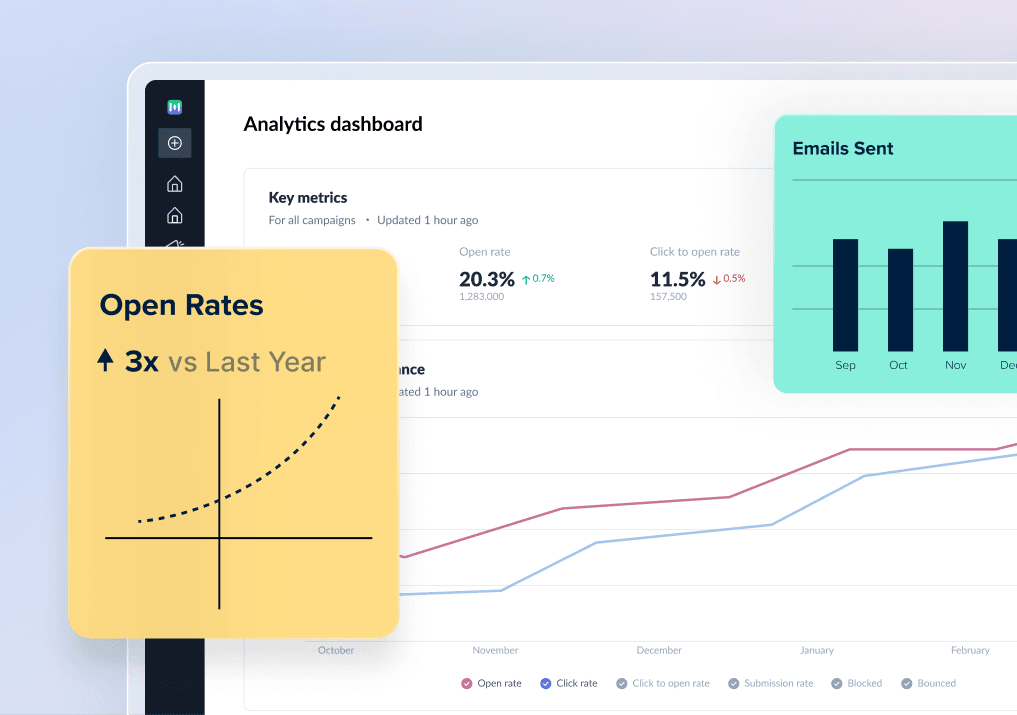Newsletters and blogs serve as valuable channels to propagate information to your target audience in digital marketing. The decision between newsletter vs. blog varies greatly depending on the goals you want to achieve using these. Understanding both channels in more detail would also allow you to choose the right channel for your brand and agenda. In this guide, you will learn about.
Table of contents
What is the difference between a newsletter and a blog?
Before discussing the differences between a newsletter and a blog, let’s understand what a newsletter and a blog is.
What is a newsletter?
A newsletter is a regularly distributed communication or publication sent to a set of recipients who have opted in to receive the newsletter. A newsletter generally contains carefully curated information, offers or updates that resonate with the recipients.
What is a blog?
A blog is a publication published online, usually on a website, to be accessed by anyone interested in reading the content of the blog or blog posts. Blog posts are published online and do not require you to subscribe.
Moving forward, let’s take a look at some of the main differences between them. The table below highlights some of the main differences.
| Newsletter | Blog |
|---|---|
| Is a direct communication, sent to the recipients via email | Is an indirect communication, published on a web page for visitors to read |
| Usually sent at regular intervals like weekly, biweekly, monthly, etc. | Does not follow a regular interval, updated at the author's discretion |
| Only people who have opted in (subscribers) receive the publication | Anybody on the internet can access the publication |
| Typically concise and to the point. Tries to deliver as much information as possible, keeping the content precise | Tends to vary in form and length |
| Usually follows a specific template to maintain consistency with past newsletters | Is more flexible in its design and formatting |
“We strongly believe in the value of newsletters as a branding tool. By maintaining frequent communication with our customers, we ensure that our brand stays top of mind. Instead of reaching out to customers only when we want them to make a purchase, we focus on building a lasting connection with them, making our brand feel more personal and human. While publishing content as blog posts holds its own significance, particularly for SEO purposes, we also utilize the option of turning our newsletters into blog posts. This allows us to repurpose and garner information that we only need to create once. Although some optimization and reformatting may be necessary, the overall effort required is minimal in the larger context.”
-Charles Chakkalo, founder, Chakkalo.com
Which one is right for you?
If you’re a new, non-established brand that doesn’t have a lot of subscribers, you should take the blog route because blogs allow you to put your content out there for anyone to see. You can grow your brand's reputation by using tactics like search engine optimization and creating content over trending topics. Gathering subscribers from this blog and starting an email newsletter with those subscribers can be the next step.
On the contrary, a newsletter requires you to have a following or an email list. If you are an established brand with subscribers, you can easily create a mailing list and start an email newsletter. You can even go ahead and set up a paywall and charge your subscribers a monthly fee.
How can blogs and newsletters work together?
Although both concepts are opposite, blogs pull the audience to your content and newsletters push the content to your audience; they can go hand in hand. As discussed, blogs can be a great way to start a newsletter because it will allow you to pull the right audience to you so they can subscribe to your content which you can then use as your mailing list for your email newsletter.
On the other hand, blogs are usually long-form content and require a lot of time on the readers’ part to get something meaningful out of it. Creators can summarize these long-form blog posts and send them as newsletters in their email marketing campaign. This will allow them to deliver the same message to the intended audience more concisely, thus reducing the time investment needed on the readers’ part. Newsletters also allow for assured deliverability of content even when the algorithm that pushes your blog posts to the audience has changed.
What should you include in your blogs and newsletters?
It is important to know the content you should put in your blogs and newsletters. All the long-form content, like guides, articles, etc., should go in your blogs. This content can target a general audience and may have more than one perspective.
On the other hand, newsletters must contain more targeted content or excerpts of longer posts. Newsletters need to be concise, to the point and well formatted. All direct communications to your recipients, including offers, promotions, news, etc., must also go through a newsletter.
💡 Related guide: 10 Email Newsletter Best Practices to Follow In 2023
Why do I prefer newsletters over blogs?
Keeping personal preferences aside, I have always preferred newsletters over blogs. Here’s a list of reasons why.
“Newsletters are more likely to be seen by customers due to their format, as they arrive in the subscriber's inbox, whereas a blog only reaches people who are actively searching for them.
Newsletters can also be shared easily, allowing customers to share great content with their networks, thus creating a larger audience for the business.”
-Jaden Oh, founder, Traffv
1. Segmentation and personalization
In email marketing, we know how important personalization is for better metrics. Blogs do not allow for audience segmentation; each blog post needs to be written keeping the multiple perspectives in mind to cater to all of them at once. On the other hand, newsletters allow for audience segmentation based on various metrics like demography, age, gender, interests, etc. Email newsletters also allow for personalization so that they resonate better with the recipients.
In other words, newsletters are direct communication where the publication is tailored to the target audience's taste.
2. Better brand loyalty
A unique characteristic of newsletters is the consistency of intervals between publications, while blogs can be more or less randomly timed. A recipient can be well aware of the timing of the newsletter, be it monthly, weekly, etc., as well as the kind of content he will receive. This consistency in delivering highly relevant content allows brands to build a closer relationship with the recipients, resulting in long-term customer relationships and loyalty.
“I've used my blog and its accompanying newsletter to promote my new startup projects in the last few months. I've found that my newsletter offered distinctly more clicks and conversions than from the blog directly, which I suspect is due to the personal brand loyalty that my email subscribers have.
For my startup Post Crunch, I received 5 times the clickthrough rates from my email subscribers compared to the blog posts where I mentioned it, despite only sending out a single email!”
-Tom Farmer, CEO, Solo Innovator
3. Targeted offers and promotions
Brands often use customer data to better understand their recipients’ preferences, interests, purchasing behavior, and more. This helps them identify the set of audiences that would be interested in a service or product, allowing them to target the right promotions and offers to the right audience, which increases the conversion rate drastically.
4. Better control over content delivery
Send time optimization focuses on the timing of the content delivery to the audience at the optimal time when the chance of conversion is the highest. Blogs do not allow marketers to control this aspect of content delivery as it is a published page and anyone on the internet can view it anytime. On the other hand, newsletters allow you to deliver your content at the optimal time to increase the chances of conversion and use send time optimization.
5. Lead generation
While in the case of blogs, a user who has read one of your posts may or may not return to view every post you publish in the future, newsletters offer a more consistent reader base. Publications are delivered straight to the readers and these readers can be nurtured over time and converted into paying customers.
6. Testing capabilities
Email newsletters allow for A/B testing to optimize your email marketing campaigns. It allows you to experiment with different subject lines, CTAs and content variations to determine what resonates best with your audience. This helps you to refine and increase the effectiveness of your newsletters.
7. Scope for cross-promotion
Newsletters act as a great channel for cross-promotion for brands. Brands already have a database of customers who are familiar with the brand. This helps them pitch new products or services to old customers who might be interested in the future.
💡 Related guide: How to Create and Launch a Paid Newsletter
8. No need to update old publications
While blogs need to be updated occasionally in case of changes in facts because they need to stay relevant with time for present readers, newsletters are one-time publications sent to the recipients to be referred to at the time of receiving. So newsletters do not require the extra time and effort of being kept up-to-date with the ever-changing facts.
9. Better analytics
Newsletters offer better analytics to understand the performance of individual newsletters. While blog post analytics can only show you metrics like bounce rate, traffic and time on page, email newsletters analytics give you a more detailed view of the open rate, click-through rate, conversion rate, unsubscribe rate and more. This allows you to make more data-driven decisions.
10. More focused
Newsletters usually have a more concise and focused format to deliver only the most important information. Unlike blogs that do not follow a specific structured format, email newsletters deliver more relevant content and maintain the readers’ attention.
How do you start your own newsletter?
Starting your newsletter may sound like a daunting task, and it is without proper know-how. Below we take you through a series of steps that will act as your step-by-step guide to starting your very own newsletter.
1. Build your mailing list
The most important aspect of newsletters is the readers. The success of your newsletter highly depends on the size and quality of your mailing list. Gathering the right kind of audience may be challenging but is highly rewarding. New brands with a limited number of followers use blogs to attract new audiences by creating content that people would want to read and then presenting an email sign-up form to them to subscribe to future updates.
Mailmodo, for instance, allows you to create opt-in forms and embed them on your blogs so your visitors can easily subscribe to your newsletters. The video below is a tutorial on using form integration in Mailmodo to generate your mailing list.
2. Segment your subscribers
Personalization is an important aspect of email marketing. Even if you run a newsletter, not every subscriber will be interested in reading everything you write about. Here comes the personalization part. If you are not providing your subscribers with highly personalized content, you may lose subscribers owing to the irrelevant content sent to them. So it is ideal to segment your subscribers based on their interests, preferences, gender, etc., to send relevant content.
You can use Mailmodo, for instance, to segment your subscribers. It allows for a variety of options too. You can have your subscriber list static segmented, which segments your current list of subscribers based on the given criteria or dynamic segmented, where your future subscribers would also be segmented using the given criteria automatically. It also allows you to create further conditions to segment them based on user details like their birthday, country and gender, campaign activity, engagement metrics and much more.
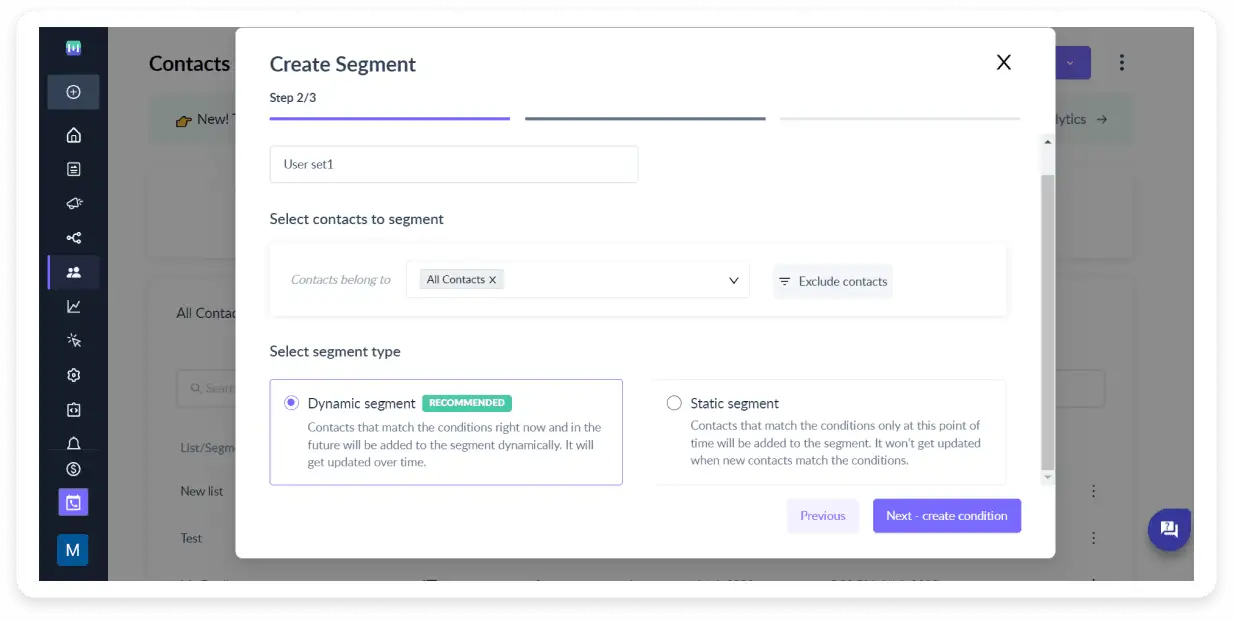
3. Design your newsletter template
Having a template for your newsletter campaign helps you maintain a consistent format and design for your newsletters, making them look more professional to your subscriber and making the process of creating newsletters easier ad faster for you.
Mailmodo offers a host of templates for your newsletter; if none suit your needs, you can create one from scratch. Their drag-and-drop editor makes it very easy to design visually appealing newsletter templates. You can customize anything from layouts, fonts and colors to company logos and images. It even allows you to embed forms and interactive widgets within your newsletter.
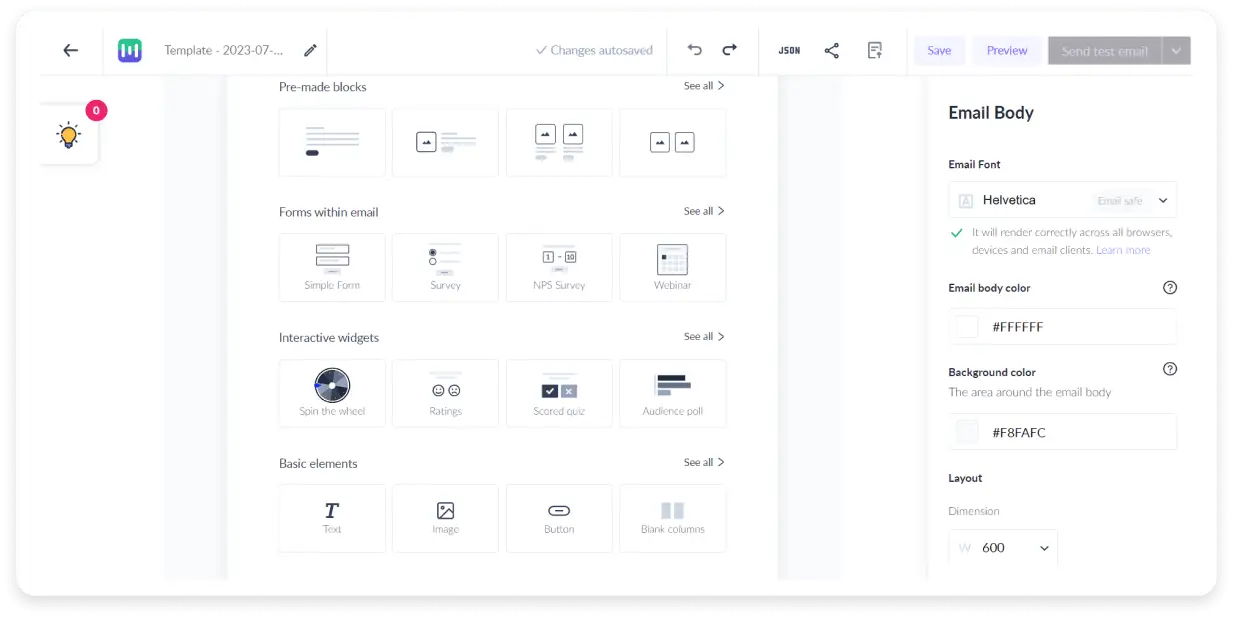
4. Create engaging and relevant content
Content is another important element of your newsletter. Your newsletter is nothing if the content you provide your target audience with isn’t relevant to them. Another thing that you must keep in mind is the presentation of your content. If you deliver a highly engaging topic, it can still lose its essence if it isn’t presented correctly. The same is true for the subject lines of your email newsletter.
Mailmodo has recently launched their AI-powered subject line generator, which can be a game changer combined with the other functionalities offered by the company. The subject line generator can automatically read your template’s content to suggest subject lines and even allows you to customize the tonality, add emojis and personalize the generated suggestions.
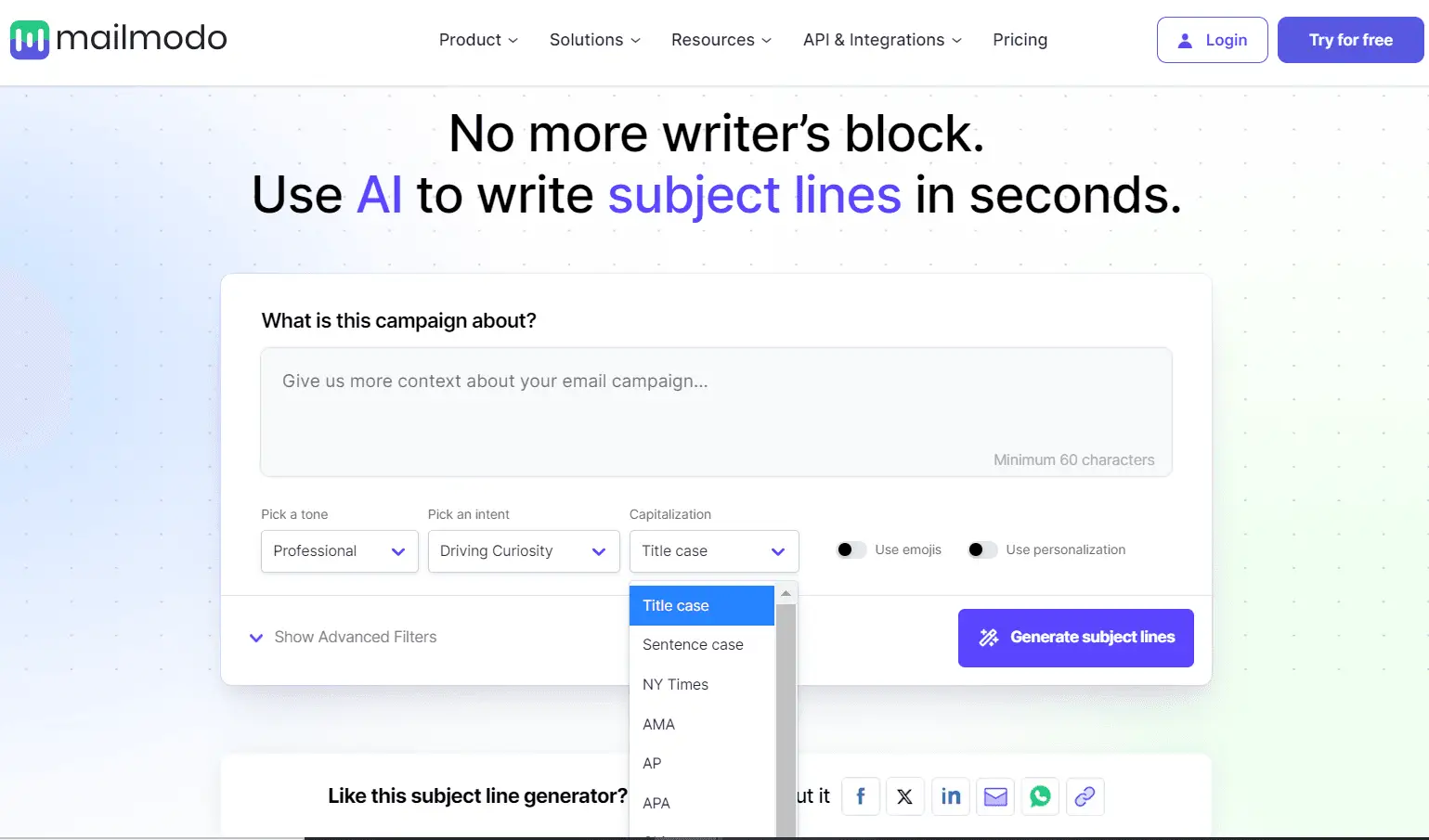
Write winning subject lines with our free ebook
Proven subject line framework to get higher opens
5. Schedule your newsletters
Sending your email newsletters at the right time increases the success rate of your campaigns. Also, consistency is very important to keep your subscribers engaged. You must determine the right frequency at which you want your subscribers to receive your newsletters, keeping in mind that too frequent newsletters may appear as spam. Scheduling your newsletters helps you maintain consistency in delivery.
Mailmodo allows you to schedule your newsletters to set them up and not worry about them being sent on time. It offers further functionalities where you can’t just schedule it for a specific time but also to be sent in the recipient’s time zone or in batches at regular intervals. Not just this, it even offers send time optimization that helps you find the perfect time for a newsletter to be sent to a recipient for the best results.
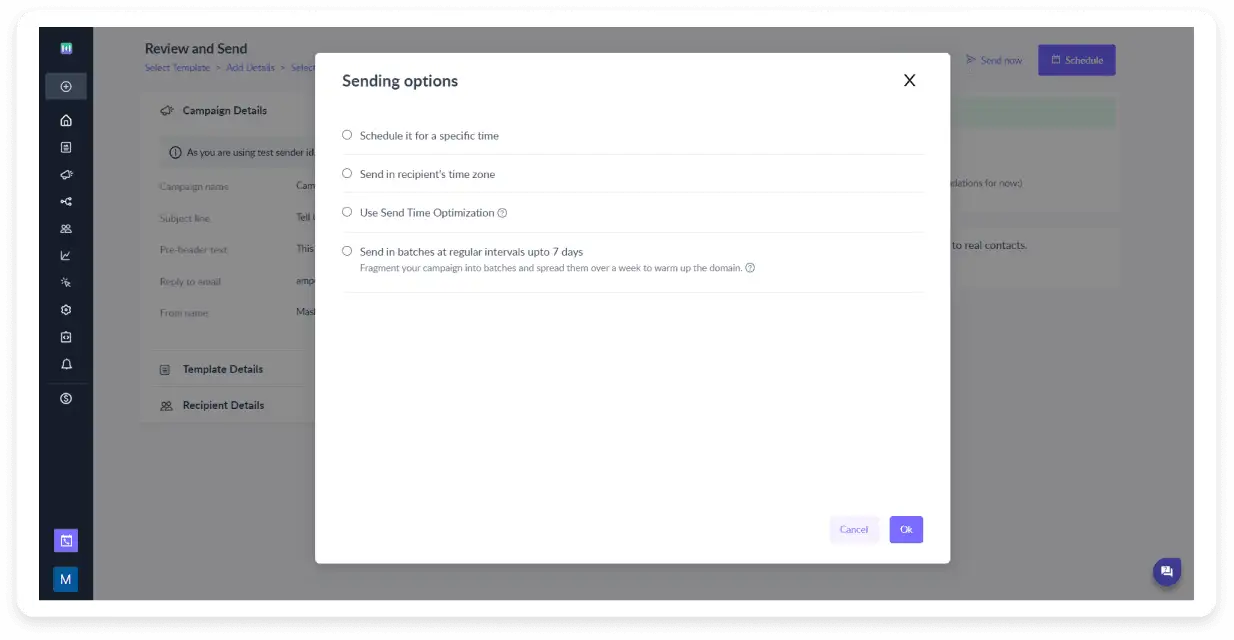
6. Test your newsletters
Before you send a newsletter to your entire subscriber list, testing it for quality assurance is necessary. This helps you to preview the layout, formatting, proper visibility of images and functionality of your newsletter across different email clients and devices. It also allows you to fix any issues with your newsletter, providing subscribers with a seamless experience.
Mailmodo offers this functionality of A/B testing. It can A/B test content and subject lines and analyze metrics such as sent, delivered, opens, clicks and submissions to deem a winner amongst the variations so you can take a more data-driven approach in selecting the right content or subject line for your subscribers.
7. Measure performance
Once you have sent out your email newsletters, you must track their performance to understand whether your newsletters resonate well with your subscribers. This also allows you to identify the issues that may be leading to poor performance and ROI so that you can fix them in future publications.
Mailmodo also allows you to measure your campaigns' performance by measuring various metrics like open rate, bounce rate, click-through rate, unsubscribe rate, click-to-open rate, engagement time, submission rate, and growth rate. This allows you to identify the drawbacks and make changes for better performance.
💡 Related guide: How to Create a Newsletter – A Step-by-Step Guide
Takeaways
So newsletters and blogs offer two different kinds of content in different ways. They also offer their upsides. Brands can achieve their goals with the right mix of blogs and newsletters. Their goals and individual needs define the right choice. A good strategy is essential to expand your audience and grow your business simultaneously.




